CFA 一级考试分析串讲
CFA一级知识点完全总结
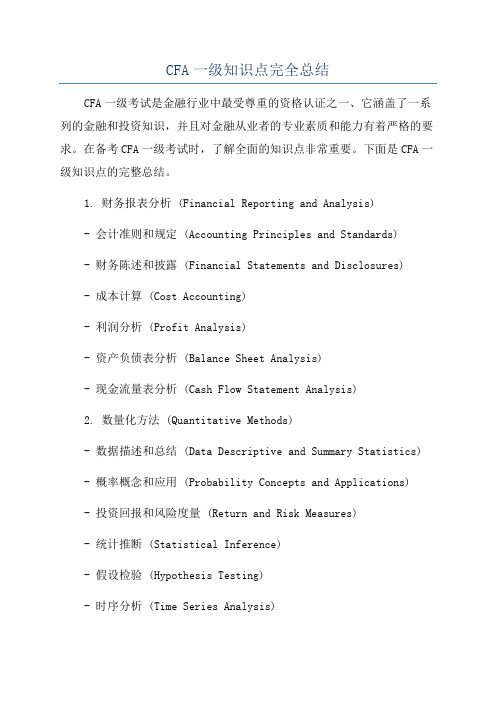
CFA一级知识点完全总结CFA一级考试是金融行业中最受尊重的资格认证之一、它涵盖了一系列的金融和投资知识,并且对金融从业者的专业素质和能力有着严格的要求。
在备考CFA一级考试时,了解全面的知识点非常重要。
下面是CFA一级知识点的完整总结。
1. 财务报表分析 (Financial Reporting and Analysis)- 会计准则和规定 (Accounting Principles and Standards)- 财务陈述和披露 (Financial Statements and Disclosures)- 成本计算 (Cost Accounting)- 利润分析 (Profit Analysis)- 资产负债表分析 (Balance Sheet Analysis)- 现金流量表分析 (Cash Flow Statement Analysis)2. 数量化方法 (Quantitative Methods)- 数据描述和总结 (Data Descriptive and Summary Statistics) - 概率概念和应用 (Probability Concepts and Applications)- 投资回报和风险度量 (Return and Risk Measures)- 统计推断 (Statistical Inference)- 假设检验 (Hypothesis Testing)- 时序分析 (Time Series Analysis)- 变量关系和回归分析 (Variable Relationships and Regression Analysis)3. 金融市场和产品 (Financial Markets and Products)- 金融市场结构 (Structure of Financial Markets)- 资产类别和金融工具 (Asset Classes and Financial Instruments)- 金融部门和参与者 (Financial Intermediaries and Market Participants)- 并购和合并 (Mergers and Acquisitions)- 利率和货币政策 (Interest Rates and Monetary Policy)- 产品创新和设计 (Product Innovation and Design)4. 伦理和专业标准 (Ethics and Professional Standards)- 伦理理论和框架 (Ethical Theories and Frameworks)- 职业道德和行业标准 (Professionalism and Industry Standards) - 投资顾问职业行为 (Investment Adviser Code of Ethics)- 投资分析师职业行为 (Investment Analyst Code of Ethics)5. 定量投资方法 (Quantitative Investment Methods)- 投资分析、评估和选择 (Investment Analysis, Evaluation and Selection)- 投资组合理论和模型 (Portfolio Theory and Models)- 投资组合构建和优化 (Portfolio Construction and Optimization)- 市场效率和有效市场假设 (Market Efficiency and Efficient Market Hypothesis)- 投资策略和风险管理 (Investment Strategies and Risk Management)- 因子模型和单因子回归 (Factor Models and Single-Factor Regression)- 投资绩效评估和报告 (Investment Performance Evaluation and Reporting)以上是CFA一级考试的主要知识点总结。
CFA一级考试六个难点分析是什么?

CFA一级考试六个难点分析是什么?1、长期收入确认的二维守则对于long-term contract,收入计量方法不是CC就是POC。
对于可以有效估计收入进度的合同,收入确认可使用完工百分比(POC)方法,在U.S.GAAP和IFRS下,根据完工过程中的百分比计算收入、费用和利润,直至工程完工。
当收入进度不能有效估计时,U.S.GAAP下使用完工合同法(CC),收入、费用和利润都在完工时确认,在此之前全部为0.而在IFRS下,并没有CC这个方法。
分析师要清楚的意识到CC的收入计量方法是最保守,最谨慎的方法。
因为POC在完工过程中盈利状态都相对漂亮,且整体平滑了损益表。
在考试中,计算题和盈利质量分析的定性题都会出现这个考点,首先需要断清进度能否可靠估计再决定会计方法,其次两种方法飞报表及ratio的影响也需要了然于胸。
2、一个固定资产的命运Expensed称为一次性消耗,而capitalized是慢慢的消耗,所以资本化不代表不费用,只是换了一个方法,在一段时间内用一种合适的方法慢慢费用。
也就是capitalize expenditure延迟了I/S费用的确认,当期利润被高估,从而retained earnings也被高估。
同时capitalize expenditure使得当期asset增加,显示出企业本身的资产状况和盈利能力都相对完美。
只不过以后的会计期间,被资本化掉的固定资产将会低估公司的利润,因为资本化的支出会通过depreciation的形成体现在未来几个会计期间中。
固定资产会计计量方法的使用不能迷惑了分析师的眼睛。
expensed是严谨的保守的会计处理方式,而capitalize不仅当期造成资产和盈利的虚高,还减少了净利润的volatility,起到了平滑利润的效果。
作为分析师要挤干报表的水分,考试中对于earning quality的分析,其中很重要的一点就是将资本化转为费用化,但请一定要注意是current period还是future,以免掉入陷阱。
CFA一级考试各科目介绍及重点解析
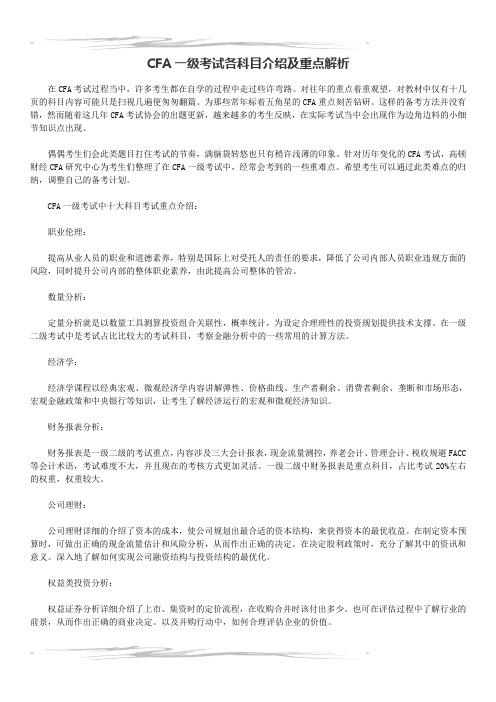
CFA一级考试各科目介绍及重点解析在CFA考试过程当中,许多考生都在自学的过程中走过些许弯路。
对往年的重点着重观望,对教材中仅有十几页的科目内容可能只是扫视几遍便匆匆翻篇。
为那些常年标着五角星的CFA重点刻苦钻研。
这样的备考方法并没有错,然而随着这几年CFA考试协会的出题更新,越来越多的考生反映,在实际考试当中会出现作为边角边料的小细节知识点出现。
偶偶考生们会此类题目打住考试的节奏,满脑袋转悠也只有稍许浅薄的印象。
针对历年变化的CFA考试,高顿财经CFA研究中心为考生们整理了在CFA一级考试中,经常会考到的一些重难点。
希望考生可以通过此类难点的归纳,调整自己的备考计划。
CFA一级考试中十大科目考试重点介绍:职业伦理:提高从业人员的职业和道德素养,特别是国际上对受托人的责任的要求,降低了公司内部人员职业违规方面的风险,同时提升公司内部的整体职业素养,由此提高公司整体的管治。
数量分析:定量分析就是以数量工具测算投资组合关联性,概率统计,为设定合理理性的投资规划提供技术支撑。
在一级二级考试中是考试占比比较大的考试科目,考察金融分析中的一些常用的计算方法。
经济学:经济学课程以经典宏观、微观经济学内容讲解弹性、价格曲线、生产者剩余、消费者剩余、垄断和市场形态,宏观金融政策和中央银行等知识,让考生了解经济运行的宏观和微观经济知识。
财务报表分析:财务报表是一级二级的考试重点,内容涉及三大会计报表,现金流量测控,养老会计、管理会计、税收规避FACC 等会计术语,考试难度不大,并且现在的考核方式更加灵活。
一级二级中财务报表是重点科目,占比考试20%左右的权重,权重较大。
公司理财:公司理财详细的介绍了资本的成本,使公司规划出最合适的资本结构,来获得资本的最优收益。
在制定资本预算时,可做出正确的现金流量估计和风险分析,从而作出正确的决定。
在决定股利政策时,充分了解其中的资讯和意义。
深入地了解如何实现公司融资结构与投资结构的最优化。
CFA一级中文精讲

精彩摘录
《CFA一级中文精讲》是一本专注于CFA(注册金融分析师)考试学习的中文 教材,它不仅为考生提供了全面的考试知识覆盖,同时也以中文的语境和表达 方式,帮助考生更好地理解和掌握CFA考试的核心内容。在这本教材中,有许 多精彩的摘录,不仅具有知识性,也具有启发性。
是关于金融市场的部分。书中提到:“金融市场是资金的汇聚之地,它连接着 储蓄和投资,是国家经济活动的枢纽。”这句话简洁明了地概括了金融市场的 核心功能,即资金的有效配置。这不仅是金融市场的本质,也是CFA考试的重 点之一。
是关于投资策略的部分。书中写道:“投资策略的选择需要根据个人的风险承 受能力、投资期限、财务目标等因素来定制。没有一种通用的投资策略能够适 合所有人。”这告诉我们在制定投资策略时,需要充分了解自己的需求和状况, 同时也要认识到市场环境的复杂性和多变性。
再者,是关于风险管理的内容。书中有一句话:“风险管理不是消除风险,而 是通过合理的资产配置和风险管理工具的使用,将风险控制在可承受的范围 内。”这意味着风险管理不是追求零风险,而是要在可承受的风险下追求最大 的收益。
这本书深入浅出地介绍了CFA一级考试的核心内容,从基本的金融概念到复杂 的投资策略,无一不包,为读者提供了一个全面的金融知识框架。然而,学习 的过程并不轻松,尤其是在涉及一些数学公式和模型时,我曾一度感到困惑。 但正是这种挑战,让我更加坚定了成为一名合格金融分析师的决心。
书中特别强调了道德和专业性在金融领域的重要性。这让我深有感触。在金融 市场这样一个充满诱惑和复杂性的环境中,保持清醒的头脑和坚定的道德立场 是每一位金融从业人员必备的品质。而CFA考试之所以如此严格,正是因为它 要求考生不仅在知识上要精通,更要在道德上达到高标准。
阅读感受
2020年CFA一级数量分析重点知识串讲
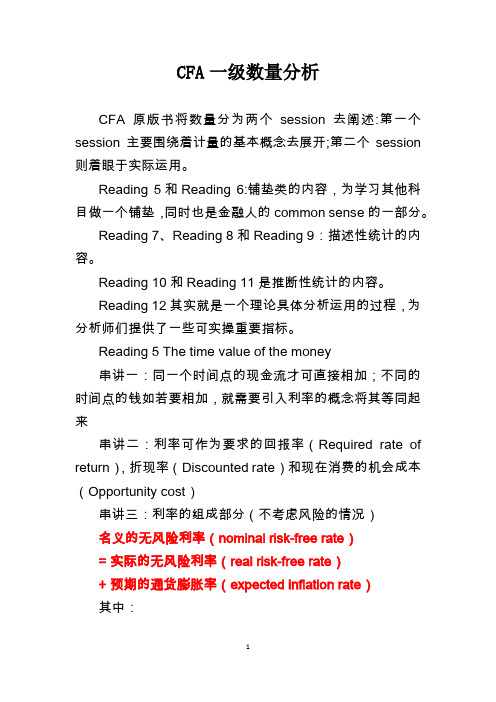
CFA一级数量分析CFA原版书将数量分为两个session去阐述:第一个session主要围绕着计量的基本概念去展开;第二个session 则着眼于实际运用。
Reading 5和Reading 6:铺垫类的内容,为学习其他科目做一个铺垫,同时也是金融人的common sense的一部分。
Reading 7、Reading 8和Reading 9:描述性统计的内容。
Reading 10和Reading 11是推断性统计的内容。
Reading 12其实就是一个理论具体分析运用的过程,为分析师们提供了一些可实操重要指标。
Reading 5 The time value of the money串讲一:同一个时间点的现金流才可直接相加;不同的时间点的钱如若要相加,就需要引入利率的概念将其等同起来串讲二:利率可作为要求的回报率(Required rate of return),折现率(Discounted rate)和现在消费的机会成本(Opportunity cost)串讲三:利率的组成部分(不考虑风险的情况)名义的无风险利率(nominal risk-free rate)=实际的无风险利率(real risk-free rate)+预期的通货膨胀率(expected inflation rate)其中:实际的无风险利率是在假定没有预期通货膨胀的情况下,单期贷款的理论利率。
注:T-bills(美国国债)的收益率,是名义的无风险利率,因为其预期的通货膨胀率不是0。
串讲四:利率的组成部分(考虑风险的情况)要求的回报率(Required interest rate on a security)= 名义的无风险利率(nominal risk-free rate)+ 违约风险溢价(Default risk premium)+ 流动性风险溢价(Liquidity risk premium)+ 到期风险溢价(Maturity risk premium)其中:违约风险溢价反映了借款人没有按期支付本息的风险流动性风险溢价反映了当出售某项投资时,获得的收入少于该投资公允价值的风险到期风险溢价之长期的债券波动性比短期的债券波动性要大。
CFA一级中文精讲①(第3版)

有效年利率(effective annual return,EAR)是一种计算投资产品年度复合收益的方法,即在本期收益 基础上将利息记入本金再投资的年度收益率。它是考虑了复利因素的收益概念。
目录分析
1投资行业的道德和 信任
2道德规范
读书笔记
其实有报名一级班,但是我本身英语水平不大好,所以还是买了这个中文精讲,考试的时候真的是帮了我太 多。
在其他机构备考二级,才发现这里还有这么好的资料。
想要系统的学习金融知识就打算考cfa,但英语实在是太渣渣啦,参加工作五年都没用上英文,中文书简直 就是我的福音,检索理解可方便了[强]。
今年毕业刚刚准备入坑cfa,网上保存了不少资源都没有动力打开看。
CFA小白一枚,一堆英文材料让我无从下手,中文精讲真的太棒了,看完一遍中文精讲再看教材,结构就清 晰了很多,内容写的也很详细易懂。
英文一直是很头疼的地方,有的时候意思大概明白,但就是捉摸不清。
因为工作需要想了解CFA相关内容,对于一个没有考过试的人来说,这本书能快速带我理解学习CFA内容,点 个赞!。
7.1外汇汇率概述 7.2外汇汇率的分类★★ 7.3外汇牌价★★★ 7.4交叉汇率★★ 7.5利率平价理论★ 7.6汇率制度★ 7.7汇率对国际收支平衡的影响
作者介绍
谢谢观看
3.1概率、期望、方差 3.2概率的表达形式以及计算法则 3.3组合的期率分布的介绍 4.2离散分布 4.3连续分布 4.4蒙特卡罗模拟
5.1推断性统计 5.2抽样 5.3估计
6.1假设检验的基本原理 6.2假设检验的步骤★★★ 6.3置信区间和假设检验★ 6.4 p值法★★ 6.5第一类错误和第二类错误★★ 6.6假设检验的分类 6.7参数与非参数检验
CFA一级考试考点复习2

CFA一级考试考点复习21. 债券的特征规定固定收益债券发行人和持有人所有权利和义务的合约被称为债券契约(Bond Indenture)。
债券合约规定(Covenant)分为肯定条款(Affirmative Covenant)和否定条款(Negative Covenant)。
否定条款即发行人应避免发生的事,而肯定性条款则为发行人承诺应做的事。
每一债券都有既定的到期日(Maturity)及票面利率(Coupon Rate),持债人可依票面利率定期收到利息,当债券到期时,投资人将可取回所购债券的票面价值( Par Value),也称面值(Face Value)或到期偿付值(Maturity Value)。
债券按付息方式分类可分为零息债券(Zero-coupon Bond)、累计债券(Accumulated Bond)、递增债券(Step-up Note)、递延债券(Deferred Coupon Bond)和浮动利率债券(Floating- rate Securities)等等。
零息债券是指在有效期内不分期支付利息的债券而于到期时一次性支付票面金额。
累计债券平时也不付息,但是投资人购买时支付的价格等于票面价值。
累计债券的利息一直以复利形式累计至到期日,加上本金额,一次性支付给投资者。
递增债券也称累进利率债券,是指利率在有效期内增加的债券。
其利率可能增加一次或者更多次。
递延债券有息票,但在债券有效期开始的一段时间内不支付利息,以复利的方式累计到该段时间结束再进行一次性支付。
于此之后,债券利息按正常水平,分次支付直至到期日。
浮动利率债券与固定利率债券相对应,是指发行时规定债券利率随某一指定利率或指数浮动的债券。
一般是先明确一个基准利率(Reference Rate) ,比如某些美债的利率或是伦敦同业拆借利率(LIBOR),再在此之上加上或减去一定的名义利差(Margin)来作为该浮动利率债券的利率。
浮动利率债券的票息公式(Coupon Formula)为:新的息票利率=基准利率+/- 名义利差。
2020年CFA一级公司理财重点知识串讲

CFA重点知识串讲-Corporate Finance公司金融Corporate Finance, 中文通常译作公司金融,或者公司理财。
在CFA一级考试中,它占比8%,难度系数在整个一级的学习科目中,为中等偏下,以理解为主。
虽然只有一个session,但包含6个主题,这构成了一个公司理财核心的三件事:钱从哪里来?钱怎么花?钱怎么分?这门课程告诉学员,一个公司,尤其是公司的高管是如何针对公司财务报表,使公司规划出最合适的资本结构,来获得资本的最优收益;在制定资本预算时,如何做出正确的现金流量估计和风险分析,从而作出正确的决定;如何在决定股利政策时,充分了解其中的资讯和意义;以及如何实现公司融资结构与投资结构的最优化并做出未来决策。
所以,这门课具有较强的实用性。
知识点一: Capital Budgeting 资本预算在众多的投资项目中,企业应当如何去做决策,这需要科学的方法论,由此衍生了资本预算理论的发展。
我们首先要了解的是资本预算的一般过程和资本预算的五大基本原则,以及在对一个项目进行评估的时候,几种主流评估方法:1)NPV (Net Present Value) 净现值法2)IRR (Internal Rate ofReturn) 内部收益率法3)Payback Period 投资回收期法4)Discounted Payback Period 贴现回收期法5)Average Accounting Rate of Return 平均会计收益率法6)Profitability Index 盈利性指数。
这其中,NPV和IRR深受大企业和学术研究的欢迎,也是考试的核心。
然而它们也有其各自优势与不足。
就NPV和IRR 的比较来说:(1)理论上看,净现值是最正确的方法,它考虑了所有的现金流情况,多个项目进行投资选择时,应该选择净现值最大的项目;(2)内部收益率法的最大优点就是以百分比的形式计算收益率,容易让人理解,但是存在多重解问题(即一个项目有可能出现两个IRR) 。
cfa一级知识点总结最全
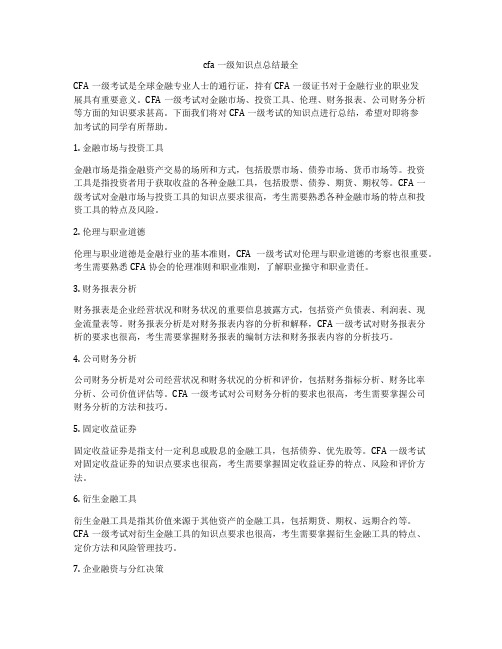
cfa一级知识点总结最全CFA一级考试是全球金融专业人士的通行证,持有CFA一级证书对于金融行业的职业发展具有重要意义。
CFA一级考试对金融市场、投资工具、伦理、财务报表、公司财务分析等方面的知识要求甚高。
下面我们将对CFA一级考试的知识点进行总结,希望对即将参加考试的同学有所帮助。
1. 金融市场与投资工具金融市场是指金融资产交易的场所和方式,包括股票市场、债券市场、货币市场等。
投资工具是指投资者用于获取收益的各种金融工具,包括股票、债券、期货、期权等。
CFA一级考试对金融市场与投资工具的知识点要求很高,考生需要熟悉各种金融市场的特点和投资工具的特点及风险。
2. 伦理与职业道德伦理与职业道德是金融行业的基本准则,CFA一级考试对伦理与职业道德的考察也很重要。
考生需要熟悉CFA协会的伦理准则和职业准则,了解职业操守和职业责任。
3. 财务报表分析财务报表是企业经营状况和财务状况的重要信息披露方式,包括资产负债表、利润表、现金流量表等。
财务报表分析是对财务报表内容的分析和解释,CFA一级考试对财务报表分析的要求也很高,考生需要掌握财务报表的编制方法和财务报表内容的分析技巧。
4. 公司财务分析公司财务分析是对公司经营状况和财务状况的分析和评价,包括财务指标分析、财务比率分析、公司价值评估等。
CFA一级考试对公司财务分析的要求也很高,考生需要掌握公司财务分析的方法和技巧。
5. 固定收益证券固定收益证券是指支付一定利息或股息的金融工具,包括债券、优先股等。
CFA一级考试对固定收益证券的知识点要求也很高,考生需要掌握固定收益证券的特点、风险和评价方法。
6. 衍生金融工具衍生金融工具是指其价值来源于其他资产的金融工具,包括期货、期权、远期合约等。
CFA一级考试对衍生金融工具的知识点要求也很高,考生需要掌握衍生金融工具的特点、定价方法和风险管理技巧。
7. 企业融资与分红决策企业融资是指企业通过债务融资或股权融资获取资金的行为,企业分红决策是指企业决定利润分配方式的决策。
CFA一级重要知识点讲解

137
NPV
2000
1000 (110%)1
1000 (110%)2
...
1000 (110%)4
=(-2000) + 909 + 661 + 451 + 137 = 158
3-26
Project Evaluation Methods - NPV
Selection For independent projects: If NPV>0, increase wealth, Accept! If NPV<0, decrease wealth, Reject! For mutually exclusive projects: Choose the one with highest NPV
Invest if IRR ≥ the required rate of return Reject if IRR < the required rate of return
Ranking Criteria: Choose the highest IRR Advantage: Reflect the profitability (not reflect absolute amount of profit gain) Disadvantage
Advantage Shows the amount of gains as currency amount Positive NPV of project adds value to the firm (or to shareholders) rather than creditors. (Creditors only gain the interest whatever project bring benefits or losses) Realistic discount rate – Included opportunity cost of funds (the expected return of stockholders)
泽稷网校CFA一级五大重点课程解析

泽稷网校-财务金融证书在线教育领导品牌.....................................................................CFA一级考试重点之:Alternative Investments这部分的内容实用性较强,即使抛开CFA考试本身而言,对于相关投资从业经验学员也会有一定的帮助。
CFA一级的Alternative包括1个study session和1个reading:Study session 18 (Alternative Investments)和Reading 64: Introduction to Alternative Investments。
以下是Reading部分的重要考点,掌握了,10道考试题基本可以拿下:Alternative Investment的基本特征;Hedge fund(对冲基金)基本特征;Private equity(私有股权基金)基本特征,不同投资策略类型,leveraged buyout(杠杆收购),venture capital(风险投资)不同投资阶段特征,private equity(私有股权基金)不同的退出策略;Real estate(房地产)投资不同形式和分类介绍,房地产指数;Commodity(大宗商品)基金特征,大宗商品期货中的重要名词contango(期货溢价),backwardation(现货溢价),convenience yield (便利收益率),期货投资收益的计算。
CFA一级考试重点之:Corporate FinanceCorporate finance这部分包括1个study session,一共6个reading,需要考生具体掌握。
整个公司金融的课程内容主要围绕如何投资项目、最大化公司财富讲述。
其中Reading 35、36、38 主要讲公司的回报;Reading 37、39、30主要讲公司的风险。
CFA考试《CFA一级》历年真题精选及详细解析1006-52
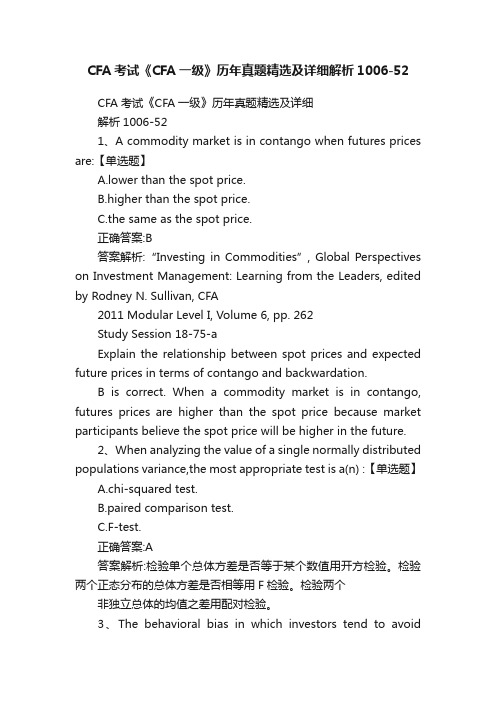
CFA考试《CFA一级》历年真题精选及详细解析1006-52CFA考试《CFA一级》历年真题精选及详细解析1006-521、A commodity market is in contango when futures prices are:【单选题】A.lower than the spot price.B.higher than the spot price.C.the same as the spot price.正确答案:B答案解析:“Investing in Commodities”, Global Perspectives on Investment Management: Learning from the Leaders, edited by Rodney N. Sullivan, CFA2011 Modular Level I, Volume 6, pp. 262Study Session 18-75-aExplain the relationship between spot prices and expected future prices in terms of contango and backwardation.B is correct. When a commodity market is in contango, futures prices are higher than the spot price because market participants believe the spot price will be higher in the future.2、When analyzing the value of a single normally distributed populations variance,the most appropriate test is a(n) :【单选题】A.chi-squared test.B.paired comparison test.C.F-test.正确答案:A答案解析:检验单个总体方差是否等于某个数值用开方检验。
CFA1级财务部分复习串讲
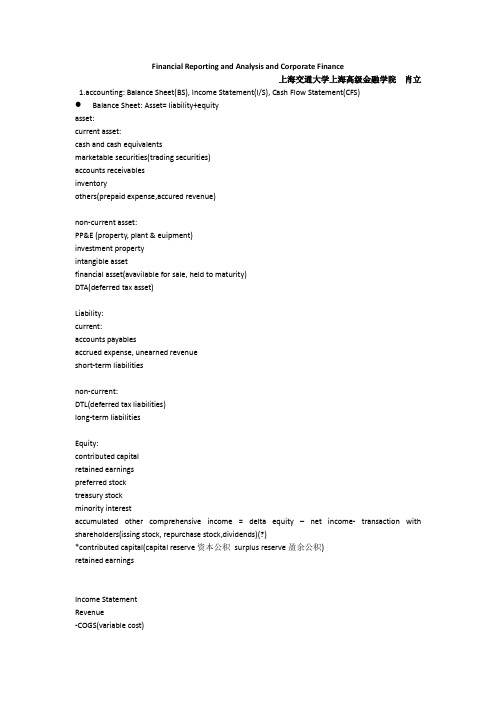
Financial Reporting and Analysis and Corporate Finance上海交通大学上海高级金融学院肖立1.accounting: Balance Sheet(BS), Income Statement(I/S), Cash Flow Statement(CFS)Balance Sheet: Asset= liability+equityasset:current asset:cash and cash equivalentsmarketable securities(trading securities)accounts receivablesinventoryothers(prepaid expense,accured revenue)non-current asset:PP&E (property, plant & euipment)investment propertyintangible assetfinancial asset(avavilable for sale, held to maturity)DTA(deferred tax asset)Liability:current:accounts payablesaccrued expense, unearned revenueshort-term liabilitiesnon-current:DTL(deferred tax liabilities)long-term liabilitiesEquity:contributed capitalretained earningspreferred stocktreasury stockminority interestaccumulated other comprehensive income = delta equity –net income- transaction with shareholders(issing stock, repurchase stock,dividends)(?)*contributed capital(capital reserve资本公积surplus reserve盈余公积)retained earningsIncome StatementRevenue-COGS(variable cost)=gross profit-selling expense, admistrative expense, financial expense(fixed cost)-depreciation/amortization-unusual or infrequent items=operating income/EBIT (EBITDA = EBIT + depreciation +amortization)-interest expense=EBT- income tax=net income from continued operations+/- income from discontinued operations+/- extraordinary items(only GAAP)+/- gain or losses from continued and discontinued operations=net incomeCash Flow Statement: CFO CFI CFFGAAP:-CFO:●payment from client and purchase to supplier●buy or sell trading securities●interest or dividend received, interest paid, tax paid●payment or money to others-CFI:●purchase or sell PP&E●purcase or sell financial securities other than trading securities●make loans to others(principal received or loans made to others)-CFF:●principal amount that lend from others (debt issued, or principal paid) ●issurance of stock (proceeds got or payment to reacquire)●dividend paid to othersIFRS:dividend, interest paid to others CFF or CFOdividend, interest received by others CFI or CFO2.recognition of asset/liablity(BS)(1)4个容易混淆的科目:(BS)●unearned revenue liability●prepaid expense asset●accured revenue asset●accured expense liability(2)physical asset and financial asset(BS, CFS)●physical asset: PP&E, inventory, investment property, intangible asset●financial asset: current asset or non-current asset? how to value them?what cash flow?⏹trading secutiry:current, fair value, CFO⏹available for sale:non-current, fair value, CFI⏹held to maturity:non-current,bond, amotized cost,CFI(3)value measurement会计计量属性(BS)●carrying value= book value账面价值●historical cost历史成本●replacement cost重置成本●recoverable value(NRV, net realizable value)可变现净值●PV of future cash flows现值●fair value公允价值3. recognition of revenue: (I/S)房地产企业签长期合同用的收入确认方法:●percentage of completion method●completed contract method分期:●installment sales●cost recovery method以物以物:●barter4.recognition of expense: (I/S)(1)COGS(variable cost):the matching principle(I/S)phase costs(fixed cost):not tied to revenue generation, such as administrative cost(2) relationship of COGS and inventory expense and Inventory expense recognition(I/S)-FIFO-LIFO-weighted average cost(考得不多)-special identification*LIFO VS FIFO? LIFO only allowed in GAAP. LIFO will result in……model: rising price, LIFO will result in higher COGS, lower inventory, lower net profit, lowertax(motivation), lower asset, lower equity, lower current asset, lower working capital = CA – CL, lower current ratio, quick ratio not change(3) depreciation expense recognition(I/S)-straight line: depreciation= histocial cost-residual value/years to depreciate-accelerated depreciation (DDB: double declining balance method) = 2(cost-accumulated depreciation)/years to depreciate-why different method?matching principle(4)amortization expense recognition(I/S)intangible assests with definite lives: straight-line amortizationwith indefinite lives: not amortized, instead they must be tested for impairment at least annually5.calculation of EPS(I/S)basic EPS=net income –preferred stock dividends/weighted average number of shares of common stock outstanding(时间加权)diluted EPS=net inome –preferred stock dividends+ convertible preferred dividends + convertible debt interest(1-t)/weighted average shares + shares from conversion of convertible preferred shares/debt/options*treasury stock method: for option/warrants exercise, firms will use the funds from options to buy back stocks, so net number of shares from options = (market price –exercise price)/market price * number of convertible shares of options6.Other things in I/S(1)Non-recurring items●discontinued operation: management has decided to dispose of but not has done yet, arereported net of tax, after income from continuing operations●unusual or infrequent items: gains or losses from sales of part of business or impairments,write-offs, write-downs, and restructuring costs, are reported before tax, included in income before continuing operations●extraordinary items: only in GAAP and reported net of tax, after income from continuingoperations, including losses from an expropriation, gains or losses from early retirement of debt, losses from natural disasters(2)Comprehensive incomecomprehensive income= net income + other comprehensive income,other comprehensive income includes:●gains or losses from foreign currency translation●unrealized gain or loss from sale of available for sale secutities●unrealized gain or loss from cash flow hedged deravative trading●adjustment of minimum pension liability(3)change in accouting principle(GAAP->IFRS) retrospective application需要向前调整change in accounting estimate(eg. residual value, years to depreciate) just need prospective change只要未来报表调整correct a wrong accounting method(eg. DDB wrong) needs prior-pediod adjustment需要往前调整一期7. Inventory(BS)(1)inventory carrying value(BS)IFRS: inventory carrying value = min(cost, NRV),NRV stands for net realizable value = selling price-selling cost-completion cost-write down ok? ok! loss in the income statement-write up(reversal) ok? ok! decrease COGS, cannot write up more than its previous write downGAAP: inventory carrying value = min(cost, market),market = replacement cost between [NRV – normal profit margin, NRV]write down ok?ok! loss in the income statementwrite up ok? no reversal!*Exception: agriculture industry, ore-mining industry inventory’s carrying value can be more than historical costs, both in IFRS and GAAP(2)delta inventory = purchase - COGS(3)periodic and perpetual inventory system(?)periodic: carrying value reviewed monthlyperpetual: carrying value reviewed continuously8.Long-lived Assets(BS)(1)capitalize vs expense(BS, I/S, CFS)-difference? the same behavior, but different accounting behavior-influence what cash flow?●capitalize CFI outflow, higher asset, higher equity (relative to expensed), higherdepreciation/amortization,第一年net income higher,之后lower●expense CFO outflow, 第一年net income lower,之后higher(2)tangible assets and intangible assests(BS, I/S)●tangible assets: property, plant and euipment(PP&E), investment property(generate rentalincome or capital appreciation)●intangible assets: identifiable or unidentifiable⏹identifiable: amortization. it can separate from the firm, it can arise from a legal right and ithas measurable worth.⏹unidentifiable: test for impairment at least annually. it cannot separate from the firm.e.g. goodwill, trademark(that can extend its effectiveness at minimum cost)*goodwill: from M&A or internally generated●M&A: capitalize, value= acquisition cost – fair value of equity●internally generated: expense(3)intangible asset: R&D expenseIFRS GAAPresearch cost expense expensedevelopment cost captialize expense*Exception: Software R&D.●for sales: after determining technology feasibility, development cost expensed -> capitalized bothin IFRS and GAAP●for own use: all capitalize in GAAP and not change in IFRS(4)carrying value of PP&E(BS): cost or revaluation modelGAAP: only cost modelIFRS: cost or revaluation model(后者很少用)cost model: carrying value = historical cost – accumulated depreciation – impairmentrevaluation model: carrying value = fair value – accumulated depreciation,●if increase or >historical cost, increased value in “revaluation surplus”●if decrease or<historical cost, decreased value in “income statement”*upward revaluation cause equity increase, asset increase, depreciation increase, profitability decrease(5)impairment of PP&E(BS)IFRS:●when to test for impairment? Annually or condition changes.●what condition to impairment? recovable price < carrying value,recovable price = max(NRV, value in use),NRV stands for net realizable value= fair value – selling cost,可变现净值value in use= PV of future cash flows现值●carrying value after impairment? recovable price●allow reversal? yes, but cannot exceed the original carrying valueGAAP:●when to test for impairment? Only condition changes.●what condition to impairment? future undiscounted cash flow < carrying value,●carrying value after impairment? fair value (if not available, use discounted future cash flow)●allow reversal? no!(6)carrying value of investment property(BS): cost model or fair value modelGAAP: no specific definition of investment propertyIFRS: cost model of fair value model●cost model: like that of PP&E●fair value model: different from revaluation. revaluation: increased value in “revaluation surplus”,fair value: increased value in “income statement”(7)DTA, DTLincome taxes = tax payable + delta DTL – delta DTA当期利润表(FS) 当期计税基础(tax)●income taxes对应accounting profit, tax payable(?)对应taxable income●why difference?●DTL?DTL: if income taxes > tax payable,计税的临时性少算;depreciation不一样,看asset value,若asset value in tax< asset value in FS,则形成DTL●DTA?DTA: if income taxes< tax payable,计税的临时性多算;depreciation不一样,看asset value,若asset value in tax> asset value in FS,则形成DTA9. Ratio for financial analysis(BS I/S) three categories:-Profitablity: revenue related or invested capital relatedrevenue related: (I/S)●gross margin=(revenue-COGS)/revenue*100%●EBIT margin=EBIT/revenue*100%●operating profit margin=operating profit/revenue*100%●net profit margin=net profit/revenue*100%invested capital related: (BS)●ROA=net profit/asset●ROE=net profit/equity●ROIC=EBIT(1-tax%)/(equity+liability),其中liability指的是融资性负债(银行借款、应付债券等),而非经营性负债(应付票据、预收收入)-asset management:(BS I/S)●accounts receivable turnover ratio, days of turnover: revenue/receivables●accounts of inventory turnover ratio, days of turnover: COGS/inventory●accounts of payable turnover ratio, days of turnover: purchase(COGS)/payables●cash conversion cycle= days of receivables + days of inventory – days of payables-financial leverage: liqudity or solvencyliquidity:(BS)●current ratio: CA/CL●quick ratio: CA-inventory/CL or cash+marketable securities+receivables/CL●cash ratio: cash and cash equivalents/CLsolvency:(BS)●financial leverage:A/E●debt-to-equity ratio:D/E●debt ratio:D/A●interest coverage ratio:EBIT/interest, EBITDA/interest-Dupont AnalysisROE=net income/equity=net income/revenue* revenue/asset* asset/equity=net profit margin* asset turnover * financial leverage10.Basics of financial reporting(1)footnotes, management discussion&analysis(MD&A), changes in equity statement, proxy statements●footnotes: accounting assumption and accounting estimates by the management, inventorydisclosure●MD&A: management’s forecasts and discussion about the future trend and past performance●changes in equity statement: delta equity●proxy statement: matters that require a shareholder vote, such as election of board members,compensation, management qualification, issurance of stock options, etc.(2)Journal entries, general ledger, trial balance●journal entries: recorded by date, or all transaction happened●general ledger: journal by account●trial balance: balance of each account(3)Fundamental characteristics and characterisitics to enhance fundamentals●fundamental characteristics: relevance and faithful representation●characteristics to enhance fundamentals: comparability, complete, neutral, variability, timely,understandable*vertical analysis: compare at the same FS, usually with one factor, e.g. revenuehorizontal analysis: compare with history performance(4)features of financial statements●fair presentation●accural basis:权责发生制●going concern basis:持续经营●consistency 一致性●materiality- free from misstatements●aggeration: similar items add together, no offseting of asset against liabilities(5)audit or assuarance opinion●unqualified无保留意见(clean)●qualified保留意见(need to explain exceptions)●adverse否定●disclaimer of opinion无法给出意见11. Cash flow statement, direct and indirect method, FCFF and FCFE(1)direct and indirect methoddirect: easyindirect: CFO = net income + depreciation/amortization –gain/+loss on disposal of assets –delta operating asset accounts(receivables, inventory, dta) + delta operating liability accounts(payables, dtl) (100 120CFI 20gain进入了net income,其实本不属于CFO)*dividend payable是属于CFF,不做加减(2)FCFF and FCFEFCFF {= CFO + interest(1-tax rate)- Capex} = net income + interest(1-tax rate)+ depreciation/amotization –Capex –delta working capital (EBIAT =EBIT*(1-tax rate)=net income + interset(1-tax rate) , delta WC= delta CA – delta CL)FCFE = CFO – Capex +net borrowing= net income + depreciation/amortization – gain/+loss on disposal of assets – Capex – delta working capital + net borrowing,net borrowing = debt issued – debt repaid12.WACC=Wd*Kd(1-tax rate)+Wps*Kps+Wce*Kce(1)cost of equityKce= d0(1+g)/P0 +g(2)cost of equity using CAPMkce=RFR+ b(Rm-RFR)(3)cost of preferred stockKps=Dps/P13.Capitla budgeting(1)NPV(2)IRR(3)payback period(4)profitablity index = PV/CF0 = 1+ NPV/CF014.two leverage: operating leverage and financial leverage(1)operating leverage: DOL= delta EBIT/delta sales= sales-TVC/sales-TVC-TF, 看一个公司控制fixed cost的水平,if there is no fixed cost, DOL=1Qobe=fixed cost/price-variable cost per unit(2)financial leverage: DFL=delta EPS/delta EBIT= EBIT/EBIT-interest,看一个公司控制interest expense 的水平,it there is no interest expense, DFL=1Qbe=(fixed cost+ interest cost)/price-variable cost per unitDTL=DOL*DFL15.pure play method(1)why this method?For lack of data, to estimate cost of projectcomparable company:Basset=Bequity /[1+(1-tax rate)*D/E]去杠杆化unleveredBproject=Basset*[1+(1-tax rate)*D/E]杠杆化leverage(2)calculation16.working capital management(1)primary source: cash balance, short-term funding, effective working capital management,●short-term funding from banks:⏹lines of credit⏹bank acceptance: for export firms, as promises from bank⏹factoring of receivables: sale of receivables at a discount to bank(2)secondary source●liquidity of long-lived assets●renegotiation of debt●filing for bankruptcy●reorganization17.several date about dividend and repurchase ways:(1)declaration date, ex-dividend date, holder-of-record date(2天后), payment date(2)repurchase ways:●repurchase in the open market:cheapest●tender offer: premium to market price●repurchase by direct negotiation: premium to market price(3)borrow funds to repurchase?cost of debt< earnings yield, increase EPS;cost of debt>earnings yield, decrease EPS.(4)repurchase will increase bookvalue?stock price<BVPS, increase,stock price>BVPS, decrease.。
- 1、下载文档前请自行甄别文档内容的完整性,平台不提供额外的编辑、内容补充、找答案等附加服务。
- 2、"仅部分预览"的文档,不可在线预览部分如存在完整性等问题,可反馈申请退款(可完整预览的文档不适用该条件!)。
- 3、如文档侵犯您的权益,请联系客服反馈,我们会尽快为您处理(人工客服工作时间:9:00-18:30)。
CFA一级考试分析串讲1-综合分析CFA第一级考试最重要的四个科目的准备重点及方向,这四个科目加起来的比重超过三分之二,所以考生一定要将准备时间的三分之二花在这四科上面。
FSA and Corporate Finance财报分析所占的比重约在23%,从单一科目来讲,这部分是最大科目,考生不仅不能忽略,更要精通。
要想在财报分析中拿高分,就必须对考试的范围每一点都下工夫。
了解每一项财务比率,了解每一个会计处理原则的改变对相关比率的影响,了解分析师重新调整会计科目以符合公司的真实价值或营运状况,对相关财务比率的影响。
公司财务管理与大学修的差不多,要掌握三大决策:投资、融资及股利。
如何计算资金成本,并运用净现值、内部报酬率及回收期选择投资案为一大重点。
融资对公司之利弊及最适资本结构的几派理论、股利政策与公司成长率之关系及股利变动对股价之影响等主题务必了解。
Asset Valuation证券市场部份比较零碎,但不困难,常考的内容包括各种指数之计算及成份、三种效率市场假说的理论及代表的含意、信心指数及融资余额等技术指针。
股票评价则以现金流量折现法去计算股票价值是必考的题型,其中又以固定成长率的Gordon成长模型及多阶段成长模型题目最为常见,考生只要多加练习,在这部份得分并不难。
Quantitative Methods这部分考30题,是最好拿分的部分。
CFA的数量分析考的比大学的统计学还简单,而且多了一些和统计学比较没有关系的观念,如连续复利的观念,随机变量分配的型态,有效年利率(Effective Annual Rate)的计算方式,夏普指数(Sharpe Ratio)、罗伊获利保本指数等(Roy’s Safety First Criterion)。
当然大部分的考题还是会集中在机率概念、平均数及标准差,分配型态(二项式分配或常态分配等)、信赖区间、假设检定及回归分析等。
其中常态分配的应用是数量分析的核心,而善用计算器的统计及时间价值的功能是统计拿高分的二大法门。
Ethical and Professional Standards此科目的投资报酬率最低,但是这科不达到一定的成绩就不能通过一级考试。
要拿高分的秘诀只有一个,那就是去买AIMR所指定的教科书:Standards of Practice Handbook。
将那本书的范例从头到尾全部看二遍,找出最有代表性的几个范例,特别是牵涉到多重违反及法条竞合的案例,自己一定要培养阅读题目时就能找出相关法条之违反的敏锐性。
反之,如果你对这一科没有把握,则考试的时候留在最后再做,没有人规定你答题的时候一定要从第一题开始答。
职业准则考试的重点包括:分析师的独立客观(Independence and Objectivity)、对客户的公平对待(Fair Dealing)、研究报告的完整性(Research Report)。
当然,利益冲突的揭露(Disclosure of Conflicts to Employer and Clients)、对雇主的忠诚(Duty to Employer),和禁止内线交易(Prohibition against the Use of Nonpublic Material Information)也不会在未来几次的考试中缺席。
同时,去年6月才列入CFA考试的全球投资绩效报告准则(Global Investment Performance Standards)规范了资产管理公司在做绩效报告时应该谨守的方法原则,也一定是考试的重点。
CFA一级考试分析串讲2-ethics\经济学\财务报表Ethical and Professional Standards①2003年12月考试中Ethics部分36题,占15%,主要有3大部分:code of ethics、professional standards、GIPS,估计今年考试可能主要集中在professional standards,还有一些就在GIPS。
②professional standards部分在2003年12月考了下面一些内容:1.laws and regulations2.use of CFA charter/candidate titles3.use of insider information(material,appropriate actions,etc.)4.duties to employers (if you are leaving your employer ,what can/cannot be done)5.duties to clients (IPO shares allocation,etc.)6.duties of a supervisor (how to deal with incompliance,etc.)GIPS部分的问题问的很直接,一般比较容易。
code of ethics:remember the exact wording of code of ethics,understand what they mean.professional standards (challenging but manageable):do as many questions as possible (from different publishers if available).focus on sorting out the priorities. in general,you should do alright if you follow the following order of priority:1.the investing public2.the profession3.your clients4.your employer5.yourselfethics is manageable if you have a clear sense of priority in mind.read GIPSEconomic1. Microeconomic主要包括供给与需求、消费者行为、成本与生产、市场结构、其中市场结构是最为重要的部分,考生必须充分熟悉不同市场结构下厂商的定价与生产行为,以及其社会福利及效率差异。
这部分是较为容易准备,因为个体经济较多使用数学与图形,大都属于局部均衡分析,对亚洲学生和平常不太注意经济政策的考生来说是很容易得分的,而且熟悉了个体经济的供需分析,学会经济学的分析工具以后,总体经济与国际经济就不会太困难了,因为经济学始终离不开供给与需求,所以在三部分中建议考生先准备个体经济,可事半功倍。
2. Macroeconomic Analysis除了如何使用货币政策和财政政策处理通货膨胀和失业等经济问题以外,不同学派比较是总体经济较重要的部分,考生必须充分熟悉不同派别对总体经济政策的主张,包括古典学派、凯恩斯学派、供给学派等在货币政策和财政政策上的差异。
除了研习教材以外,如果时间充裕的话,平常多阅读总经新闻和评论,从生活中学习也是扎根的方法,毕竟实际的总体经济现象较课本复杂很多,而且考生都是目前任职或将来想投入金融行业的人员,有了坚实的经济知识基础,未来在职场上也会受用无穷。
3. Global Economic Analysis主要包括国际贸易和外汇市场。
国际贸易所占比重不多,汇率制度、外汇套利行为、汇率平价关系等反而占有较多份量。
这部分多为计算题例如汇率换算、套利报酬等,只要理解个中原理就不难应付。
以上仅对CFA的经济学Level 1考试内容作一重点提示,考生还是须根据AIMR的学习指南加以详细研读,并且要多做模拟考题,把理论应用到解题上以及增加实战经验。
不过,CFA考试的科目相当多,如果只考经济学一门,当然可以自行购买CFA的参考书籍自修,但需要有相当的毅力与恒心,而且要忍受孤军作战的寂寞。
近年来坊间有许多辅导机构举办各种投考CFA的专业课程,有意取得CFA证照的同学不妨也可以考虑透过这种方式准备考试,相信可以节省不少自行摸索的时间,也可以认识一些志同道合的考友,一起共同勉励和互相打气,往CFA的专业资格迈进。
Financial Statement Analysis主要有下面几个重要部分:1. 财务比率这个部分是财务分析师在从事分析时的工具,CFA 考试所需准备的比率相当多,但考生可以将所有比率先按其性质区分为:内部流动性的分析比率、营运效率比率、营运获利能力比率及财务风险比率等,再来背诵,会事半功倍。
在CFA 的考试除了会考简单的财务比率之外,常会考的是当会计处理方法不同时,其各项财务比率的增减变动情形。
考生在研读其它会计主题时,须同时注意对各项比率之影响。
2. 存货存货系会计上蛮重要的一个主题,CFA 的考试着重于各项成本流动假设之比较分析。
诸如:先进先出(FIFO)、后进先出(LIFO),及FIFO与LIFO相互变更之影响。
另外,期末存货的评价也是重点之一,如成本市价孰低法{LCM}之评价。
至于存货与销货成本之间的公式亦是考生一定要会的。
考题也常出现公式之间各项金额之增减变动,考生一定得注意。
3. 固定资产考试重点在固定资产的折旧控制方式,各种方法都不难,但须注意折旧提取的多寡影响损益大小,所以考题除计算折旧金额外,亦须注意其对损益的影响。
4. 公司债主要是考核考生对公司债的发行及溢折价摊销的处理,只要理解正确并不困难。
5. 租赁CFA考试考核的是最基础的会计处理,但内容稍多,考生可能多花点时间在这个部分,因为租赁又区分为营业租赁与资本租赁。
6. 所得税所得税的观念在于时间性的差异造成财务会计所得与课税所得的不同,造成财务会计所得与课税所得的不同,造成财务报表的所得税费用与申报所得税的应付所得税的差异。
所以考生须注意当会计处理方法对财务会计与税务上不同时,就会产生递延所得税的资产或负债,考生须花更多时间在所得税这个主题,因为除了事先要学习会计处理方法之不同外,得再进一步其对于所得税之影响,考生不得不花点心思在所得税。
7. 保留盈余及每股盈余这个主题很重要的就是在计算基本每股盈余及稀释每股盈余,因其计算较为复杂,考生真得多多练习考题,勤于计算,特别是稀释每股盈余更要注意计算时分子、分母之加减情形。
8. 现金流量表不论是理科或文科考生对现金流量表都不是很熟悉,特别是需编此表那就更难了,但CFA考试并不考编表,纯粹是考观念,所以考生只要把观念理清楚就不难了,因为现金流量表把公司的现金流量区分三种活动,所以考生一定要非常清楚什么现金流量是属于什么活动,而且进一步要知道是现金流出或流入,考题就是在这些观念打转,考生须把重点摆在观念的建立。
